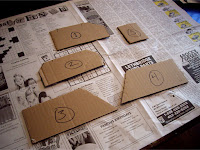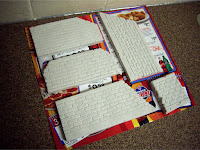I’ve been avoiding the construction of the abutments for my trestle and bridge for a while, mostly because I didn’t have the slightest idea of how I was going to construct them. I am now at the point where I cannot continue my layout terrain without the abutments being in place. I knew I wanted the abutments to have a brick look, so I started to do some research on how to accomplish this. I found 2 options; the first to use brick-textured styrene, or to cast the abutments in plaster. I opted with the latter option, mainly due to the fact that the one and only hobby shop in my city didn’t carry any type of brick styrene or similar material.


I first started by making a cardboard template of each abutment to ensure that it fit properly on the layout. I notated on each template the front and back so I didn’t somehow mix them up. I then used each template to create a basic form out of heavy cardstock and masking tape, ensuring that the face of the mold was level and flat. Remember also that the form needs to be built in the REVERSE direction of the front of the template, or in other words, the template should lay in the form back-side facing up. This is a mistake that I narrowly avoided, which would have resulted in backwards abutments.

I used plaster of paris for the castings, mixing it to the consistency of oatmeal. I then quickly filled the form to about 1cm thick, shaking the form to evenly settle the plaster. While the plaster set, I butted books up against each edge of the form to prevent the form’s walls from bowing. Cardstock worked fine for this type of casting, as long as the plaster wasn’t too moist and runny, which would warp and tear the form.


After the casting set for about 10-15 minutes, I gently tore away the paper form. I then smoothed out and rough edges, which were most apparent on the back side. At this point the plaster was solid, but still wet enough to carve. I used a ruler and a scissor blade to carve the bricks. After the cast was a little firmer, I etched cracks and gouges in the bricks to make them look a bit more weathered. I then gave the abutment a final brush with a firm nylon brush, giving the plaster some texture, as well as removed any loose plaster pieces.


Because plaster (especially plaster of paris) has such a fast setting time and short window to work with, I only cast and carved one abutment at a time. If I had even poured two at the same time, the second would be too hard to carve by the time I finished the first.


0 (mga) komento:
Mag-post ng isang Komento